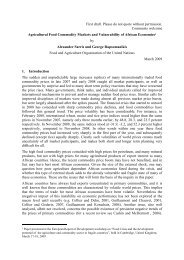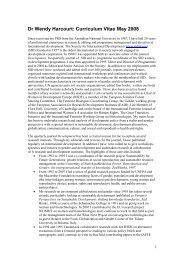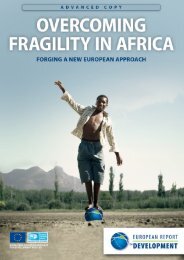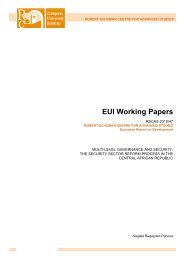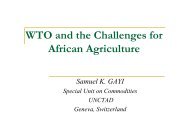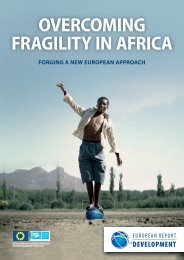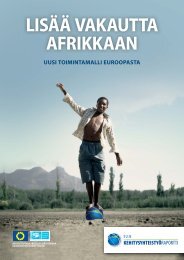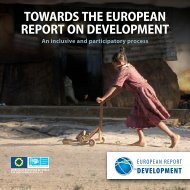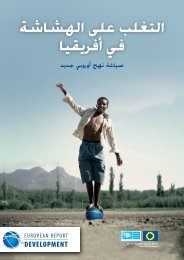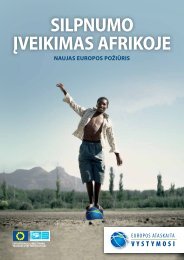Extending Health Insurance: Effects of the National ... - ResearchGate
Extending Health Insurance: Effects of the National ... - ResearchGate
Extending Health Insurance: Effects of the National ... - ResearchGate
You also want an ePaper? Increase the reach of your titles
YUMPU automatically turns print PDFs into web optimized ePapers that Google loves.
information found in <strong>the</strong> Women’s Questionnaire, but was shorter because it did not contain a<br />
reproductive history or questions on maternal and child health or nutrition.<br />
3.2 Background Characteristics<br />
We present simple descriptive statistics <strong>of</strong> <strong>the</strong> main background characteristics that will be used in<br />
subsequent sections <strong>of</strong> <strong>the</strong> paper. Table A.2 shows <strong>the</strong> distribution on women age 15-49 and men<br />
age 15-59 by selected background characteristics including age, marital status, urban/rural<br />
residence, region, literacy, education, religion, ethnicity, wealth status and occupation.<br />
The age distribution shows that more than half <strong>of</strong> women (56 percent) and men (49 percent) are<br />
under age 30. The proportion <strong>of</strong> respondents in each group generally decreases as age increases<br />
reflecting <strong>the</strong> young age structure <strong>of</strong> <strong>the</strong> Ghanaian population.<br />
Fifty-nine percent <strong>of</strong> women are married or in union, compared with 53 percent <strong>of</strong> men. Because<br />
men marry later in life than women, 43 percent have never married, compared with 32 <strong>of</strong> women,<br />
who are, on o<strong>the</strong>r hand, more likely than men to be widowed, divorced, or separated. The<br />
distribution <strong>of</strong> respondent by urban/rural residence shows that 48.5 percent <strong>of</strong> women and 54<br />
percent <strong>of</strong> men live in urban areas. They are mostly concentrated in <strong>the</strong> Ashanti region and in<br />
Greater Accra. About one in ten are from <strong>the</strong> Western, Central, Eastern, Nor<strong>the</strong>rn, Volta and Brong<br />
Ahafo regions. The Upper East and Upper West regions have <strong>the</strong> smallest proportion <strong>of</strong><br />
respondents.<br />
Literacy and education are particularly important because <strong>the</strong>y have been found to be closely<br />
associated with <strong>the</strong> health <strong>of</strong> women and children and with <strong>the</strong> demand for health care services.<br />
Data show that men have more education than women. Sixty-three percent <strong>of</strong> women and 46<br />
percent <strong>of</strong> men are not able to read a full sentence. Twenty-one percent <strong>of</strong> women have never been<br />
to school (compared with 14 percent for men), 20 percent (15 percent for men) have some primary<br />
education, 55 percent (62 percent for men) have some secondary education and 4 percent (9 percent<br />
for men) have attained more than secondary education.<br />
The majority <strong>of</strong> respondents are Christians: 78 percent <strong>of</strong> women and 72 percent <strong>of</strong> men. The rest <strong>of</strong><br />
<strong>the</strong> respondents are Muslims (15 percent <strong>of</strong> women and 17 percent <strong>of</strong> men) and o<strong>the</strong>r (spiritualism,<br />
animism, o<strong>the</strong>r). For what concerns ethnicity, Akan is <strong>the</strong> largest ethnic group, with 51 percent <strong>of</strong><br />
women and 48 <strong>of</strong> men, followed by <strong>the</strong> Mole Dagbani and <strong>the</strong> Ewe.<br />
10



